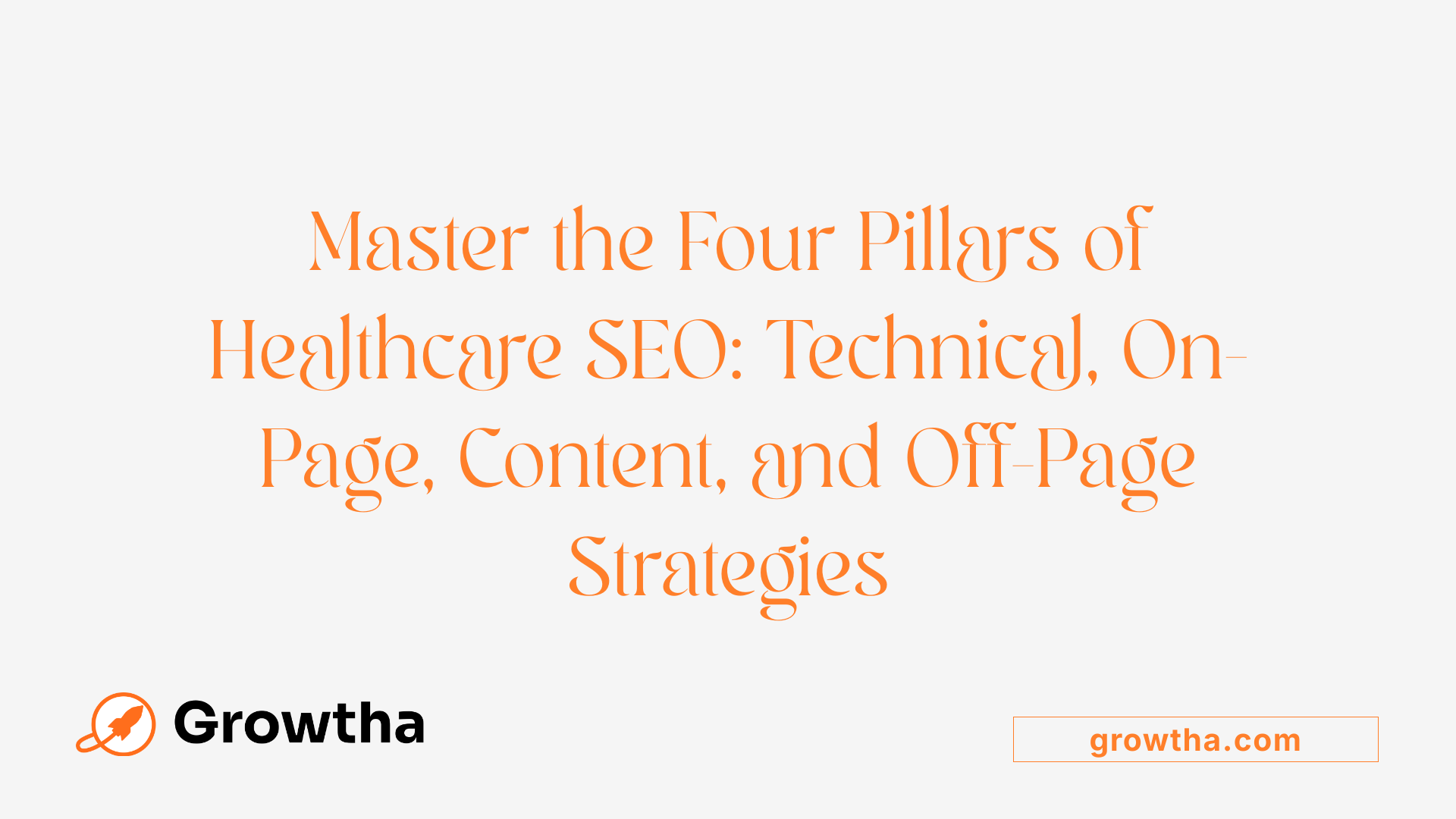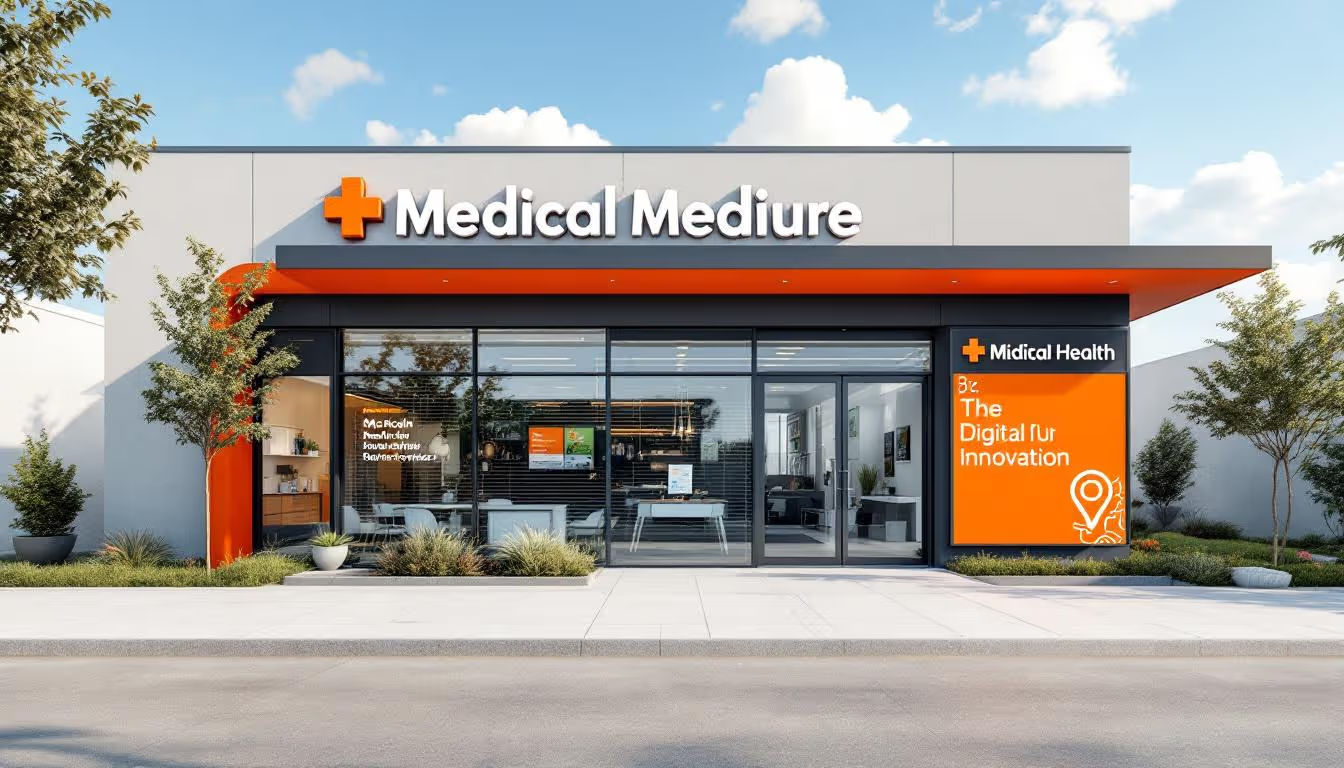How to Optimize Medical Blog Content for SEO
Mastering Healthcare Content Visibility in the Digital Age


How to Optimize Medical Blog Content for SEO
Unlocking the Secrets of SEO for Medical Blogs
In today's digital landscape, medical professionals and healthcare organizations must leverage search engine optimization (SEO) to enhance their online presence, attract new patients, and establish credibility. Crafting SEO-optimized medical blog content requires understanding multiple core pillars, implementing effective strategies, and staying updated with emerging trends. This comprehensive guide explores the critical components of healthcare SEO and offers practical tips for creating content that ranks higher in search engine results and engages your target audience efficiently.
Understanding the Four Pillars of SEO in Healthcare

What are the 4 pillars of SEO?
In healthcare SEO, achieving high search engine rankings requires focusing on four essential areas, often called the pillars of SEO. These pillars work together to improve your website’s visibility, credibility, and user experience.
The four pillars are: Technical SEO, On-Page SEO, Content Optimization, and Off-Page SEO.
Technical SEO covers all behind-the-scenes aspects of your website. It involves making sure your site is easily crawlable and indexable by search engines. Important factors include website speed, mobile responsiveness, secure HTTPS connections, structured data (schema markup), sitemap configuration, and fixing crawl errors. A well-structured technical foundation helps search engines understand and rank your content better.
On-Page SEO focuses on optimizing individual web pages. It involves editing page titles, meta descriptions, headers, URLs, and incorporating keywords naturally into the content. Internal links and logical site structure also fall under this pillar. These elements improve relevance to search queries and enhance the user experience.
Content Quality and Relevance emphasize creating valuable, accurate, and engaging medical content. High-quality content should be authoritative, up-to-date, and built with the trustworthiness principles of E-E-A-T (Experience, Expertise, Authority, Trust). Regularly updated blogs, FAQs, patient guides, and educational articles help establish your practice’s credibility and meet patient intent.
Off-Page SEO Strategies include activities outside your website to boost authority and reputation. Building backlinks from reputable healthcare sites, managing online reviews, and leveraging social media are vital. These efforts increase your site’s trustworthiness and improve overall search rankings.
By understanding and implementing these four foundational components, healthcare providers can enhance their online visibility effectively. Focusing on each pillar ensures comprehensive SEO success, attracting more patients and building lasting trust.
Implementing Technical SEO for Medical Blogs

How is SEO used in healthcare?
Healthcare SEO is essential for elevating the online presence of medical practices, clinics, and health information websites. It incorporates various strategies such as keyword research, high-quality content creation aligned with E-E-A-T principles—Experience, Expertise, Authority, and Trustworthiness—and technical website optimizations. These efforts ensure that healthcare content is easily discoverable and trusted by both search engines and patients.
Technical SEO forms the backbone of successful healthcare websites. It focuses on improving website speed, enhancing mobile responsiveness, implementing structured data markup, securing the site through HTTPS, and managing crawlability with XML sitemaps.
Fast-loading websites provide a better user experience and are favored by Google, which helps improve rankings. Mobile responsiveness ensures that patients accessing information via smartphones or tablets have a seamless experience, which is critical given the high volume of mobile searches.
Structured data, or schema markup, helps search engines understand healthcare content better. It can improve visibility through rich snippets, making your listings more attractive in search results.
Security measures like HTTPS not only protect sensitive patient information but also positively influence search rankings, as Google prioritizes secure websites.
Finally, XML sitemaps and diligent crawl error management help search engines index your site efficiently. Regular updates and error fixes ensure that your website remains accessible and performant.
By strategically implementing these technical aspects, healthcare websites can increase their search visibility, attract more high-intent patients, and foster trustworthiness and professionalism online.
This holistic approach to technical SEO is vital for medical blogs seeking to connect with patients effectively and ethically.
More about technical SEO for healthcare websites
To deepen your understanding and enhance your healthcare SEO efforts, consider exploring detailed guidelines and best practices tailored for health information platforms. Search queries like 'Technical SEO for healthcare websites' can yield comprehensive resources and case studies that illustrate successful optimization strategies.
Optimizing On-Page Elements for Medical Blog Success

How can I optimize SEO for blog posts?
Optimizing SEO for medical blog posts involves multiple strategic steps to enhance visibility and credibility. Begin with thorough keyword research to understand the terms your target audience uses when searching for healthcare information. Use tools like Google Keyword Planner, SEMrush, or Ahrefs to find relevant, high-volume keywords.
Incorporate these keywords naturally into your blog titles, headers, and throughout the content. This not only helps search engines understand your content but also improves reader engagement. Make sure to include keywords in meta descriptions and image alt text for better indexing.
Structuring your content for readability is essential. Use clear subheadings, bullet points, and concise paragraphs to make the information easy to digest. Providing high-value, accurate, and up-to-date information builds trust and authority.
Implement internal linking by connecting related blog posts or pages within your website. This guides visitors to more relevant content and helps search engines crawl your site efficiently.
Enhance your blog with schema markup, especially for medical content. Structured data helps search engines understand the context of your content, improving the chances of gaining rich snippets and featured excerpts in search results.
Finally, focus on user experience by ensuring your website is mobile-friendly, loads quickly, and is easy to navigate. Good readability, fast speeds, and an intuitive layout keep visitors engaged and lower bounce rates.
Regularly analyze your performance using tools like Google Analytics and Search Console. Track rankings, traffic, and engagement metrics to refine your SEO strategies continuously. Consistent updates and optimization efforts are vital for maintaining high search engine rankings and attracting potential patients.
By implementing these on-page SEO techniques, your healthcare blog can achieve better visibility, authority, and user trust, ultimately supporting your practice's growth.
Developing High-Quality Content Through E-E-A-T Principles

What are the 4 pillars of SEO?
The four main components of SEO are Technical SEO, On-Page SEO, Content Optimization, and Off-Page SEO.
Technical SEO involves enhancing your website's foundation to make sure search engines can easily crawl and index your site. This includes optimizing site speed, ensuring mobile responsiveness, fixing crawl errors, and structuring your site logically.
On-Page SEO focuses on optimizing specific page elements such as titles, meta descriptions, headers, and internal links. This helps make your content more relevant and easier for users and search engines to understand.
Content Optimization centers around producing high-quality, authoritative, and helpful content aligned with what users are searching for. Incorporating relevant keywords naturally and demonstrating expertise are essential here.
Off-Page SEO pertains to activities outside your website, like obtaining backlinks from reputable sources, managing your online reputation, and engaging on social media platforms. These efforts increase your site's authority and visibility.
In healthcare, applying these pillars effectively is crucial to rank higher, attract more patients, and establish credibility and trustworthiness online.
Ensuring Content Accuracy and Use of Recent Research
To uphold trustworthiness in healthcare, all content must be accurate and based on the latest research. This involves reviewing current medical studies, guidelines, and authoritative sources to ensure information is up-to-date.
Involving Medical Experts in Content Creation and Review
Content should be developed or vetted by qualified healthcare professionals. Their involvement guarantees the material is precise, reliable, and adheres to medical standards.
Highlighting Qualifications and Credentials of Authors
Displaying authors’ credentials, certifications, and professional experience builds credibility. Patients and search engines recognize these signs of authority and trust.
Providing Clear Sources and References
All health information should be backed by verifiable sources, with links to relevant studies, guidelines, or official publications. Transparency fosters trust and complies with regulatory requirements.
Maintaining Transparency and Privacy Compliance
Clear privacy policies, secure data handling, and compliance with regulations like HIPAA are essential. Transparency about data use and privacy safeguards reassures visitors privacy is protected.
By integrating these E-E-A-T principles—Experience, Expertise, Authority, and Trustworthiness—healthcare websites can deliver content that ranks well on search engines and most importantly, provides genuine value to patients seeking medical guidance.
| Aspect | Focus | Importance |
|---|---|---|
| Experience | Real-world healthcare experience of content creators | Enhances credibility |
| Expertise | Medical qualifications and professional knowledge | Builds trust |
| Authority | Recognized authoritativeness of the content and sources | Improves ranking |
| Trustworthiness | Transparency, accuracy, privacy adherence | Maintains compliance and trust |
Applying these principles systematically helps healthcare providers stand out in search results and create a trustworthy online presence. For more insights, search 'E-E-A-T in healthcare content'.
Leveraging Off-Page SEO and Backlink Building
What are the 3 C's of SEO?
The 3 C's of SEO are Content, Code, and Credibility. Content pertains to the quality, relevance, and accuracy of the information on your website, which search engines mainly analyze through HTML text and structured data. Code involves ensuring your website’s technical structure is optimized with relevant keywords in titles, META tags, and a clean, standards-compliant layout to facilitate better crawling and indexing. Credibility is established through acquiring high-quality backlinks from reputable, relevant healthcare sites; this not only boosts your site’s authority but also signals trustworthiness to search engines.
Building a strong off-page SEO profile in healthcare requires strategic efforts across different areas. One vital component is earning backlinks from respected healthcare organizations, universities, or government health agencies. These links serve as votes of confidence, improving your site’s domain authority.
Guest blogging and collaborating with healthcare influencers can expand your reach. Writing authoritative articles for prominent health websites or contributing expert opinions helps generate high-quality backlinks while positioning your practice as a trusted source.
Creating shareable and authoritative content such as health guides, research summaries, or patient education materials encourages other sites to link back naturally. Engaging content also promotes social sharing, which can indirectly enhance your SEO.
Online reviews are critical for reputation management and local SEO. Active review generation and response strategies increase trust and influence your rankings in local search results. Valued reviews demonstrate credibility and community engagement.
Finally, engaging with local communities and directories by maintaining accurate NAP (Name, Address, Phone Number) information, adding localized content, and participating in community health events can improve your visibility and authority within your geographic area.
Overall, combining these off-page strategies with on-site SEO creates a comprehensive approach that boosts your healthcare practice’s online discoverability and credibility.
Harnessing Local SEO for Medical Practices and Blogs
How can medical practices optimize their Google Business Profile?
Creating and optimizing a Google Business Profile is essential for local SEO success. Ensure all information is accurate, complete, and consistent across all online directories. This includes updating your practice's name, address, phone number (NAP), business hours, services offered, and high-quality images. Regularly monitor and respond to reviews, which boosts engagement and credibility. Using Google Posts to share updates and community events also helps maintain active listing presence.
How does using location-based keywords improve local search visibility?
Incorporating location-specific keywords into website content, meta tags, headers, and URLs helps search engines associate your practice with local search queries. For example, using keywords like "pediatrician in Brooklyn" or "dentist near downtown Atlanta" aligns your site with patient searches in your geographic area. This targeted approach makes your practice more visible to potential patients searching for local healthcare providers.
Why are patient reviews important for local SEO?
Online reviews are pivotal in building trust and influencing search rankings. Positive reviews not only attract new patients but also signal trustworthiness to search engines. Encourage satisfied patients to share their experiences on platforms like Google, Yelp, and Healthgrades. Responding promptly and professionally to reviews shows active engagement and commitment to patient satisfaction, which can enhance your local search status.
How can managing local citations benefit healthcare SEO?
Local citations—mentions of your practice’s NAP details across online directories and local business listings—are crucial for consistency and authority. Ensure your practice is listed on reputable health directories, local chamber of commerce sites, and healthcare review platforms. Keep all citations up-to-date to prevent confusion and improve trustworthiness, which positively influences search engine rankings.
What strategies can help create localized content and foster community engagement?
Developing localized content such as blog posts about community health events, local health tips, or patient success stories fosters a strong local presence. Engage with the community through sponsorships, hosting health seminars, or participating in local events. Sharing this on your website and social media platforms not only boosts local relevance but also encourages backlinks and online mentions, strengthening your local SEO efforts.
Continuous Monitoring and Adaptation in Healthcare SEO
How can I optimize SEO for blog posts?
To keep healthcare websites performing well in search rankings, ongoing monitoring and adjustments are crucial.
Using tools like Google Analytics and Search Console allows website owners to track important metrics such as traffic patterns, bounce rates, and keyword rankings. These insights reveal what’s working and what needs improvement.
Based on this data, strategies should be flexible. For instance, if certain keywords aren’t generating expected traffic, consider updating content or targeting different related terms. Regularly reviewing and refreshing blog content also keeps it current and authoritative, which search engines favor.
Perform frequent technical audits to identify issues like slow load times, broken links, or mobile incompatibility. Fixing these issues improves user experience and boosts SEO rankings.
Staying informed about search engine algorithm changes is vital. As Google updates its ranking factors, adapting content and technical practices ensures continued visibility.
Engaging with patient feedback through reviews and comments provides real-world insights. Incorporating common questions or concerns into your content can enhance relevance and trust.
In summary, continuous monitoring with analytics tools helps refine healthcare SEO strategies, ensuring that your practice remains visible, trustworthy, and patient-focused. Regular website audits, timely content updates, staying current with algorithm shifts, and listening to your community are fundamental for sustained SEO success.
Regulatory Compliance and Ethical Considerations in Healthcare SEO
Ensuring Content Accuracy and Privacy
In healthcare SEO, accuracy is paramount. Content must be based on the latest research, verified by medical professionals, and clearly cited. Protecting patient privacy is also critical; websites must comply with privacy laws like HIPAA by avoiding the publication of personally identifiable health information without explicit consent.
Adhering to HIPAA and FTC Guidelines
Strict standards govern healthcare websites. HIPAA compliance ensures sensitive patient data remains confidential, while the Federal Trade Commission (FTC) emphasizes honest advertising and transparent disclosures. Both regulations help maintain trustworthiness and legal integrity.
Transparent Policies and Contact Information
Providing clear policies and accessible contact details builds trust. The website should include privacy policies, terms of use, and professional credentials. Displaying comprehensive contact info allows users to verify the legitimacy of the practice and consult with qualified staff.
Verifying Facts with Medical Experts
All healthcare content must be reviewed and approved by qualified medical practitioners. This practice ensures the information's credibility and aligns with E-E-A-T principles—Experience, Expertise, Authority, and Trustworthiness—ranking factors evaluated by Google.
Avoiding Black-Hat SEO Techniques
Black-hat tactics like keyword stuffing, cloaking, or buying backlinks should be avoided. These can lead to penalties and damage a practice's reputation. Instead, focus on ethical SEO strategies such as high-quality content creation, organic backlink building, and user-focused site design.
By adhering to these standards, healthcare providers can improve their online presence responsibly while safeguarding patient trust and complying with legal requirements. Regular updates and transparency reinforce credibility, ensuring long-term success in medical SEO practices.
Final Thoughts: Building a Sustainable SEO Strategy for Healthcare Blogging
How can healthcare providers effectively integrate all SEO pillars?
Creating a sustainable healthcare SEO strategy involves a balanced approach that combines technical optimization, high-quality content, on-page SEO, local engagement, and backlink development. Ensuring a logical site structure with fast load times, mobile responsiveness, and security helps lay a solid technical foundation. Complementing this with consistent production of authoritative and accurate content builds trust and authority.
On-page elements such as compelling titles, meta descriptions, and header tags should be keyword-rich yet natural, aiming to improve both user experience and search engine rankings. Local SEO tactics—like optimizing Google Business Profiles, encouraging reviews, and using location-specific keywords—are crucial for attracting nearby patients.
Backlink strategies should focus on earning high-quality links from reputable healthcare sources, further boosting domain authority. Regular performance tracking via tools like Google Analytics and Search Console ensures all components work synergistically, adapting strategies as needed.
Achieve Search Visibility and Build Trust
Optimizing medical blog content for SEO is a multifaceted process that demands strategic planning, continuous monitoring, and adherence to regulatory standards. Emphasizing quality content aligned with E-E-A-T principles, implementing thorough technical and on-page optimizations, and cultivating off-page authority through backlinks and local engagement are crucial components. By adopting a people-first approach and staying abreast of industry trends, healthcare providers can significantly enhance their online presence, attract high-quality traffic, and foster enduring patient trust. Remember, effective healthcare SEO isn’t a one-time effort but an ongoing journey towards digital excellence.
References
- How to Use Content Marketing and SEO to Grow Medical Practice
- Healthcare SEO: The Ultimate Guide to Medical SEO - SeoProfy
- SEO For Medical Practices: 6 Best Strategies - ResponseScribe
- SEO for healthcare: How to boost your medical practice's organic traffic
- How to Optimize Healthcare SEO with E-E-A-T Strategies
- SEO for Doctors: Power of Blogging - Updated for 2025 - PracticeBeat
- [PDF] Medical Website Best Practices to Increase SEO - Boston Scientific
- How to Optimize Content for SEO to Rank Higher
- 8 Things SEO Healthcare Bloggers Should Know - Omnicore Agency
- How To Optimize Health Websites For SEO: A Comprehensive Guide







